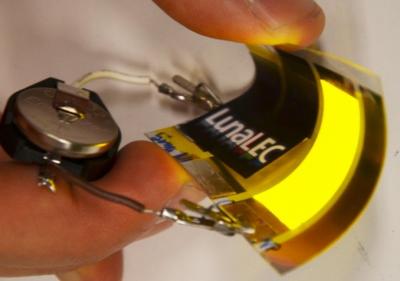In 2012 we posted about light-emitting electrochemical cells (LEC), a cheaper (but less efficient) flexible alternative to OLED lighting. Back then, three Universities (in Sweden and Denmark), involved with Polymer LEC (P-LEC) research, launched a company called LunaLEC to develop and commercialize the technology.

Now LunaLEC unveiled a new technology that can be used to fabricate 3D LECs in air using spray-spintering. This fault-tolerant fabrication technique can produce multi colored large-area emission patterns via sequential deposition of different inks based on identical solvents. The technique can also be used to deposit LECs on complex-shaped surfaces - for example the fork you see above. This is done in-air without the use of cleanrooms.

Polymer LEC panels are similar to PLEDs in structure, but in LECs the emitter polymer is blended with an electrolyte (e.g. LiCF3SO3 dissolved in PEO). LECs, which require only three layers, were first reported 17 years ago, but they suffered from very low lifetime and efficiency. Even with recent advances (mostly better electrodes) LECs are still not on par with OLEDs regarding performance (lifetime and efficiency) - but they are much easier to produce.
Back in 2012, LunaLEC reported that their current LEC devices feature about 10 lm/W and 5,600 hours of lifetime. The company said they are using an all-fluorescent device, and if they change to phosphorescent materials it can bring LEC efficiency up to par with OLED (but with a probably downgrade in lifetime).
Later in 2012, it was revealed that OSRAM are also actively researching organic LECs (OLECs), and indeed they viewed them as a mid-term technology (until OLED catches on) for low-cost wide-area luminaries. Since then we have not heard of any advances from OSRAM.
For more information, see the original research paper here.
Comments
The LEC technology has the ability to provide all colors, since a lot of light-emitting material that work in OLED-technology also work in LEC components. Tang et al published work in JACS last year J. Am. Chem. Soc., 2013, 135 (9) as well as in early works in 2011, showing the broad wavelength distribution from a white LEC. However, this is still early work that has to be developed into viable applications.
With regards to tuning, there is no theoretical limit as to which colors we can create. Each individual panel, or object, will though for the foreseeable future have a constant color, whether solid or patterned in different shades/colors.
Patric Stafshede, LunaLEC


While this technology sounds interesting, it doesn't sound like it will be able to produce a pleasing white light, and unless I am missing something, its ability to be "tuned" is non-existant. Therefore, even with high production capability it sounds like a specialized niche product (which I guess is redundant) within the lighting field.